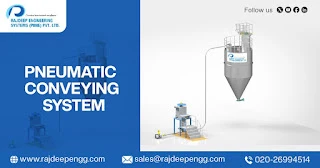Pneumatic conveying systems are revolutionizing the way industries handle bulk materials, offering a multitude of benefits over traditional mechanical conveying methods. These systems use air or gas to transport materials through pipelines, providing a clean, efficient, and versatile solution for material handling. In this blog, we explore the key advantages of pneumatic conveying systems and why they are becoming the preferred choice for many industries.
Versatile Material Handling
One of the standout advantages of a pneumatic conveying system is its ability to handle a wide range of materials. Whether dealing with fine powders, granular products, or even small pellets, these systems can efficiently transport various materials without cross-contamination. This versatility makes them suitable for industries such as food processing, pharmaceuticals, chemicals, and manufacturing.
Clean and Contaminant-Free Transport
Pneumatic conveying systems are designed as closed systems, ensuring that materials are fully enclosed during transport. This design minimizes the risk of contamination from external sources, which is crucial for industries that require high standards of hygiene and safety, such as food and pharmaceuticals. The enclosed nature also helps in maintaining the purity of the materials being conveyed.
Flexible and Space-Efficient Routing
The flexibility of pneumatic conveying systems allows for complex routing options that can navigate around obstacles and over long distances, both horizontally and vertically. This flexibility makes it easier to integrate these systems into existing plant layouts, making better use of available space and simplifying the installation process.
Minimal Dust Generation
Another significant advantage of pneumatic conveying systems is their ability to minimize dust generation. The closed system design ensures that materials are contained, reducing the amount of dust released into the environment. This feature is particularly important in industries that handle fine or hazardous materials, as it helps maintain a cleaner and safer working environment.
Gentle Handling of Materials
Pneumatic conveying systems are known for their gentle handling capabilities. By controlling the air velocity and pressure, these systems can transport materials without causing damage or degradation. This gentle handling is especially beneficial for fragile or delicate materials that require careful transport to maintain their quality and integrity.
Energy Efficiency and Cost-Effectiveness
Modern pneumatic conveying systems are designed to be energy-efficient. They optimize airflow and pressure, reducing the overall energy consumption and operational costs. This energy efficiency, combined with the reduced maintenance requirements due to fewer moving parts, makes pneumatic conveying systems a cost-effective solution for material handling.
Easy Maintenance and Reliability
With fewer moving parts compared to mechanical conveying systems, pneumatic conveying systems are easier to maintain. This simplicity translates into less wear and tear, reduced downtime, and increased reliability, ensuring continuous operation and productivity.
Conclusion
Pneumatic conveying systems offer numerous advantages, including versatile material handling, clean and contaminant-free transport, flexible routing, minimal dust generation, gentle material handling, energy efficiency, and easy maintenance. These benefits make them an ideal choice for various industrial applications, enhancing efficiency, safety, and cost-effectiveness.


